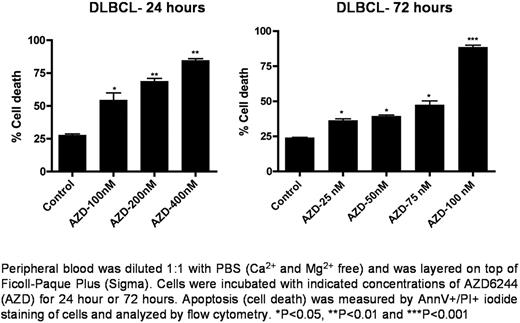Abstract
Abstract 285
MCT-1 is an oncogene that has been shown to induce cell proliferation and activate cell survival pathways and is constitutively expressed in the majority of diffuse large B-cell lymphomas (DLBCL). MCT-1 is phosphorylated by the MEK/ERK kinases, which occurs directly upstream of MCT-1; thus MEK/ERK inhibition blocks the phosphorylation and activation of MCT-1. Potent small-molecule inhibitors of MEK have been developed in pre-clinical and clinical studies that have shown the MEK/ERK pathway can be effectively shut down in a highly selective manner. However, the majority of pre-clinical and clinical information regarding MEK inhibitors to date have emerged mainly from solid tumor studies. The study of anti-MEK therapy is largely unexplored in lymphoma. The benzimidazole AZD-6244 (ARRY-142886) is a novel 2nd generation small molecule MEK antagonist being developed for the treatment of cancer. We investigated the activity of AZD-6244 in DLBCL cell lines, primary cells, and an in vivo xenograft model.
DLBCL cell lines (SUDHL4, SUDHL6, OCI-LY3, and OCI-LY19) and primary cells obtained from a patient with relapsed/refractory transformed DLBCL (absolute lymphocyte count 167.3 K/UL, hemoglobin 9.8 gm/dL, and LDH 1,141 Units/L (high normal 195 Units/L)) were incubated with increasing nanomolar concentrations of AZD-6244 (50-400nM) for 24–72 hours (hr). MTT was calculated and apoptosis was determined by fluorescence-activated cell sorting using AnnexinV-FITC/propidium iodide (AnnV+/PI+) staining. Cleaved caspases and phosphorylated ERK (pERK) and MCT-1 (pMCT-1) were assessed through Western blot studies. In vivo studies were performed with mice bearing subcutaneous tumors of SUDHL6 that were randomly divided into control and AZD-6244 groups. SUDHL6 cells (1.2 × 106) were subcutaneously injected into left and right dorsal flanks of 7-week-old female SCID mice. When the tumor reached the size of approximately 60-163mm3, AZD-6244 was administered intraperitoneally every other day at a dose of 1.0 mg/kg body weight for a total of 3 weeks.
Time-dependent cytotoxicity was documented in each of the 4 DLBCL cell lines. IC50 at 48 hours in SUDHL4 and OCI-LY3 was 130nM, 240nM in SUDLH6, and 300nM in OCI-LY19. Dose-dependent apoptosis was also seen in all cell lines. Compared with control at 48 hrs, >50% AnnV+/PI+ was documented in SUDHL-4 at 200nM and with 300-320nM in the three other cell lines (p<0.01). Interestingly, minimal cleavage of caspases 3,8, or 9 were seen. In terms of target inhibition, 100nM of AZD-6244 effectively down-regulated p-ERK in each of the cell lines, while 200-300nM was required for significant down-regulation of pMCT-1. In primary DLBCL cells, dose- and time-dependent apoptosis was also seen (Figure below). At 72 hrs, 100nM of AZD-6244 resulted in >75% AnnV+/PI+ (p<0.001). In terms of the in vivo studies, the average tumor volume of AZD-6244-treated and control SCID mice with standard deviation was calculated as a function of time. From 28 weeks on, mice treated with AZD-6244 had significantly and increasingly less average tumor volume compared with control (p<0.05).
Collectively, these data show that the 2nd generation MEK small molecule antagonist AZD-6244 induced significant cell death at nanomolar and clinically achievable concentrations in multiple DLBCL cells lines, primary cells, and in an in vivo xenograft model. In addition, AZD-6244 effectively downregulated the critical pro-growth kinase pERK, and the downstream oncogene, MCT-1. Clinical study of AZD-6244 in DLBCL is warranted, while continued investigation of the role of the MEK/ERK/MCT-1 signaling cascade in lymphogenesis is needed.
No relevant conflicts of interest to declare.
Author notes
Asterisk with author names denotes non-ASH members.


This feature is available to Subscribers Only
Sign In or Create an Account Close Modal